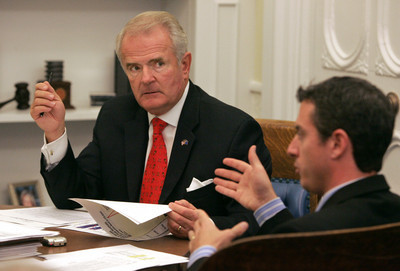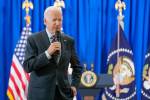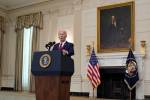Budget cut plan juggled
CARSON CITY -- Gov. Jim Gibbons announced a plan on Friday to spread the pain of an ever-worsening state budget shortfall by cutting virtually every state agency and program, including public education, by 4.5 percent per year.
The governor's plan to address a revenue shortfall now estimated at $440 million, was a mixed bag for state government.
Some state agency directors, who had been asked in October to find a way to slice budgets by 8 percent per year, were instead looking at a smaller trim to spending. Others that previously had been exempt, including public safety, public education and corrections, suddenly found themselves under the budget-cutting knife.
Spared from cuts were child welfare and juvenile justice programs.
Gibbons said he decided to spread the pain around after seeing the severe effect the 8 percent cut would have on the targeted agencies, particularly human resources.
The approach is fairer and eliminates the need for any employee layoffs, he said.
"This is a much more favorable approach to reducing state budgets," he said.
"Taking 41/2 pennies out of every dollar that we are providing is not a Draconian measure," Gibbons said. "It is much more doable."
Gibbons was not expected to announce a plan to address budget woes until next month, but he said the sooner the decision was made, the better agencies and education officials could plan for the spending reductions.
There were quick responses, many of them critical, to the announcement that the cuts now would include public education to the tune of $96 million statewide.
"We're stunned. We're shocked," Clark County School District Superintendant Walt Rulffes said, "because it's somewhat unbelievable that one day K-12 is protected from budget cuts, and this afternoon we find the governor is proposing a cut."
Nevada Assembly Speaker Barbara Buckley, D-Las Vegas, used one word to describe how she felt about the governor's announcement: "blindsided."
"I met with the governor yesterday (Thursday), but he didn't mention he was cutting K-12 education," she said. "I'm extremely disappointed that education funding was cut."
But Senate Majority Leader Bill Raggio, R-Reno, called Gibbons' approach prudent. "It's less severe across all the agencies," he said.
The education cuts could come from programs such as the newly expanded full-day kindergarten, which could be delayed until revenues rebound, Raggio said.
The spending reductions are expected to generate nearly $284 million in savings. The remainder of the $440 million revenue shortfall will be made up by tapping the state's rainy day fund and making cuts in capital construction and other one-time expenditures.
The plan doesn't require a special session of the Legislature. Lawmakers can tap the rainy day fund to the tune of between $100 million and $200 million when they convene in February 2009.
Even with the cuts, the state general fund budget will grow by more than $700 million over the previous two-year budget.
Gibbons said state spending on public education still will increase by $294 million over the previous two-year budget. The public education spending reductions can be made without layoffs, cuts to teacher salaries or impacts on class size or services.
State funding this biennium is still going up 15 percent for public education, said state Budget Director Andrew Clinger. When all sources of revenue to the public schools are added up, per pupil expenditures will grow this year to $7,764, up 9.2 percent, and to $8,183, up 5.4 percent, next year.
While Rulffes expressed surprise at being included in the cuts, Gibbons said the superintendents of the state's 17 school districts were advised of the impending reductions.
Gibbons gave only the targeted amounts, and school districts and the higher education system may implement cuts as they see fit.
The districts are, however, being given a list prepared by Gibbons' staff of cuts that could be made without affecting students.
"The superintendents ... were anticipating that there would be a reduction in the state revenues and they have actually already planned on this," Gibbons said.
But Rulffes said there are problems with Gibbons' suggested cuts because some money already has been spent.
A $14.6 million remodel of food service kitchens already has been completed and paid for, and roughly two-thirds of the $53 million set aside for a district software system already has been spent, he said.
"There are some faulty assumptions in the cuts that they're talking about," he said.
Should the district be required to pay back money that already has been spent, the district would have to stop hiring teachers and stop buying school buses, according to Rulffes.
"I think this is the kind of situation that leads the public to take things in their own hands, which results in these initiatives," such as the one by the Nevada State Education Association that proposes raising taxes on casino revenue, Rulffes said.
Word that public education is now part of the cuts angered other education leaders, as well.
Lynn Warne, president of the Nevada State Education Association, which represents the state's teachers, said Gibbons' plan is "hurting the kids in this state."
"When we are operating on a bare-bones budget, there's not much fat there to cut," she said.
Some were less critical.
University system Chancellor Jim Rogers, who has so far refused the governor's request to come up with a plan to cut the higher education system's budget, said a 4.5 percent cut was better than an 8 percent cut.
"The question is, how much better?" he said.
On Monday, system officials will begin to look at specific cuts for the state's seven colleges and the Desert Research Institute, Rogers said.
The university system cuts will now total just under $58 million. The system had been facing a cut of $102 million under the 8 percent cut per year scenario.
While critical of the inclusion of public education, Buckley said it's good that the governor is tapping the rainy day fund. She also noted that the cuts to social services won't be as drastic as the 8 percent slice that had been contemplated by Gibbons.
That kind of cut would've forced mental health facilities to shut down, she said, and "that was never a feasible or viable plan to begin with."
Instead of a $140 million hit, the Department of Health and Human Services will have to cut $78 million under the final plan. The smaller cut reduces the loss of matching federal funding for programs.
Buckley said she had urged the governor to delay construction projects instead of cutting the operational budget to make up the deficit. "I think the cuts could've easily been avoided," she said.
Raggio gave the governor points for calling on agency heads to prepare contingency plans ahead of the announced cuts.
"Most of them have some ability to freeze position vacancies, cut administrative costs, things of that kind," he said. "Cut out some areas that are nice but not necessarily needed. And hopefully, it's temporary."
Clark County Commission Chairman Rory Reid, who butted heads with Gibbons over the possibility of cuts to child welfare, said he was pleased the programs were exempted. In October, Reid complained that the state has long underfunded juvenile services and any further cuts would damage the system.
"He had previously committed to protect the most vulnerable citizens and I'm glad he is living up to that commitment," Reid said.
Gibbons said state agency directors will implement their own cuts to hit the required targets. Details of where each agency plans to make the reductions will be revealed to the public next month.
Gibbons said it is a "bottom up" approach, giving those in charge of the different agencies and programs the choice of how to hit the targets.
Constitutional officers -- treasurer, secretary of state, attorney general, controller and lieutenant governor -- along with the other branches of government, including the Supreme Court and the Legislature, also have been requested to make cuts.
State employee and teacher salary increases built into the budget also are exempted from the reductions.
News of potential budget reductions first surfaced in October, after several dismal reports on taxable sales. Many of the state's main revenue sources, from gaming to sales to the real property transfer tax, are coming in lower than projected.
The two-year, $6.8 billion budget approved in June was based on the more optimistic projections.
The size of the shortfall has steadily worsened. It was projected at $285 million earlier this week, but now is expected to hit $440 million by the end of the next fiscal year.
Gibbons said his budget cuts account for what is expected to be the worst-case scenario.
"If it comes in better, we're all the better off," he said. "But let's not plan for something better and have to go back and make another adjustment."
Review-Journal writers Alan Choate and Adrienne Packer contributed to this report. Contact Review-Journal Capital Bureau reporter Sean Whaley at swhaley@review journal.com or (775) 687-3900.






























